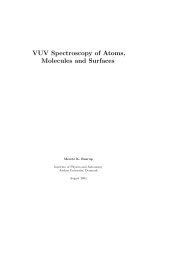Paramount GT-1100 Robotic Telescope Mount
Paramount GT-1100 Robotic Telescope Mount
Paramount GT-1100 Robotic Telescope Mount
Create successful ePaper yourself
Turn your PDF publications into a flip-book with our unique Google optimized e-Paper software.
<strong>Paramount</strong> User’s Guide page 59<br />
·<br />
·<br />
·<br />
� ID - Index error in Dec<br />
� NP - Non-perpendicularity in RA/Dec<br />
� CH - Non-perpendicularity of the OTA in Dec<br />
� ME - Error in polar axis elevation<br />
� MA - Error in polar axis azimuth<br />
Do not just go to Suggest Terms command that allows TPoint add terms;<br />
these are merely suggested terms, and must be analyzed and evaluated before<br />
you can trust them. That's very challenging to do. There's a better way. Add,<br />
then evaluate for effect on the model, the following terms:<br />
� TX – Tangent tube flexure. This is generally better to use than TF; it<br />
combines for greater accuracy with the other terms.<br />
� HCES and HCEC – Centering errors in the RA gear.<br />
� DCES and DCEC – Centering errors in the Dec gear.<br />
The above terms are almost always beneficial. Next step is to evaluate the<br />
other named terms (except those with AAT in the name; those are for the<br />
Anglo-Australian telescope, not the <strong>Paramount</strong> ME). Look for terms that,<br />
when used, will significantly reduce the Sky RMS and PSD values. (RMS =<br />
root mean square error; PSD = population standard deviation.) Never use a<br />
term that increases the PSD, no matter if it also reduces the RMS. Terms that<br />
provide only minimal improvement (less than 10% better RMS) should not<br />
be used. Terms that do not provide at least 2-3 units improvement in RMS<br />
should not be used. I have found that the following terms are commonly<br />
useful for me; your results may vary – check every term's impact on your<br />
model! Other useful terms include: HDSD4, HHCH4, HHSH4<br />
At this point, you can now try Suggest terms. Use the same rules for<br />
suggested terms as for named terms: make sure they show enough of an<br />
improvement in your point to be included. However, when suggesting terms,<br />
you should always take an additional step: test the term in practice. Suggested<br />
terms can be very useful; they can be completely bogus. The name says it all:<br />
these are _suggested_ terms. They have been found to be of _possible_<br />
statistical significance; you need to verify that by seeing how they affect real<br />
pointing, not just the RMS and PSD. Having a low RMS is not the same as<br />
having great pointing!<br />
Note: Adding and evaluating terms is a non-trivial exercise. The more you know about<br />
mathematics, and statistics in particular, the more effective you can be at selecting, analyzing,<br />
and evaluating terms. Read up on TPoint, the mathematics and the concepts behind<br />
telescope modeling – it will make you more effective at selecting terms. Also, be patient. It<br />
takes time and effort to learn TPoint and the vast logic behind it. The good news is that the<br />
more time you invest in TPoint, the more you will get out of it.<br />
If you experience problems with ProTrack, the first place to look is at the terms you added<br />
to your model. Terms must be evaluated by how they improve or hurt your pointing and/or















